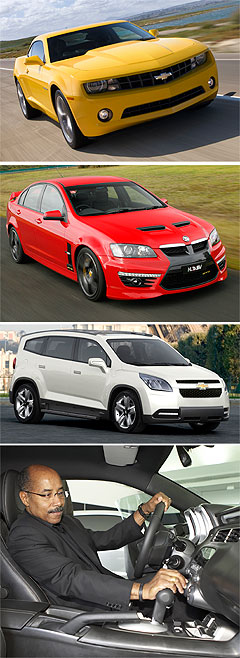Holden’s bid for Corvette design
BY RON HAMMERTON | 10th Mar 2010

The Melbourne-based group is one of 10 GM design studios around the world that have been invited to submit studies for the ‘C7’ in what amounts to a GM competition to give the ‘Vette more appeal to younger drivers in North America, as well as to overseas buyers for whom the current car is often regarded as a symbol of old-iron sledgehammer motoring compared with the high-tech thoroughbreds from Europe.
And those studies might include a pioneering Euro-style four-door ‘coupe’ alongside traditional two-door coupe and convertible layouts, as mooted by GM vice-chairman and product leader Bob Lutz in 2007.
The invitation to GM design studios around the world to submit drawings for the Corvette was made last year by GM vice-president of global design Ed Welburn who told Automotive News that some of the resultant designs were “absolutely phenomenal”, adding that no decision had yet been taken.
Holden’s expertise in designing and engineering rear-drive performance cars potentially puts it at the head of the list of would-be contenders for the task of designing the Corvette, which is due in about 2012, possibly as a 2013 model.
Holden played a lead role in engineering the current, super-successful Chevrolet Camaro from its Australian-designed rear-drive Zeta platform that also underpins the Holden Commodore, ill-fated Pontiac G8 and forthcoming Chevrolet Caprice Police Pursuit Vehicle for US law-enforcement agencies.

The Canadian-built Camaro has been one of GM’s success stories as it fights its way out of Chapter 11 bankruptcy proceedings, selling at the rate of about 6000 a month – 10 times the volume of the more expensive Corvette.
While it is unclear if the next Corvette would adopt a variation of the Zeta architecture, one of the sharp-edged sportscar’s traditions has been its unique rear suspension system, employing a transverse leaf spring that does double-duty as an anti-sway bar on the independent set-up.
However, Mr Welburn’s decision to throw what has been an exclusively American exercise open to world input suggests all such traditions are open to revision.
As well, new economic realities in the American motor industry might also preclude such niche luxuries when a perfectly adequate alternative already exists in other GM vehicles, including Holden Special Vehicles cars that already employ high-performance Corvette V8 power and torque.
Sales of the Corvette peaked at 53,000 in 1979. Last year, the global economic crisis pulled the rug from the model’s US sales, which plunged 48 per cent from 35,310 units in 2008 to just 16,956 – its lowest ebb since 1962, except for 1997 when a break in production between generations restricted sales to fewer than 10,000.
The appeal of the current Corvette – launched in 2005 – lies mainly with middle-aged, middle-American male drivers who see such V8 cars as part of the American dream, but GM fears the concept is failing to generate new business among cashed-up Gen X and Y motorists who have looked to Japan and Europe for inspiration.
The key will be to mix just enough tradition into the new model to satisfy the current clientele with a sufficiently powerful breath of fresh air to woo new business.
As Mr Welburn told Automotive News: “We have a lot of challenges in the States with Corvette. The average age of the customer is really rising.”Although Holden is tight-lipped on the project, design director Tony Stolfo told GoAuto at last year’s Melbourne International Motor Show that Holden was working on design projects for GM affiliates overseas, including North America.
“We’re working on programs for Brazil, Korea, China, even Opel, and obviously North America as well,” he said.
“We’ve all got our own finger in the pie. And it’s critical, because we really need to make sure that whatever cars are being designed in Korea are relevant for here, relevant for North American markets, and so on.”Holden Design’s main competition for the Corvette job may well come from its own former staffers, who populate other GM design studios around the world, including the main operations at Warren in Michigan, Russelsheim in Germany and GM Daewoo's Bupyeong studio in South Korea.
These include the design director for Chevrolet, former chief Holden designer and the man behind Australia's born-again Monaro, Michael Simcoe, and Cadillac exterior designer Max Wolff, who penned the CTS.
The precursor to Holden's next Barina, the Chevrolet Aveo RS concept, was styled by GM designer Ondrej Koromhaz and built by the GM Holden technical centre in Port Melbourne for the 2010 Detroit motor show.
The striking VE Commodore-based GMC Denali XT dual-cab ute concept was designed and built by Holden Design's Warrack Leach for the 2008 Chicago show, while GM's 2008 Paris motor show star, the Cruze-based Chevrolet Orlando seven-seat people-mover concept, was designed in Korea and built by Holden.